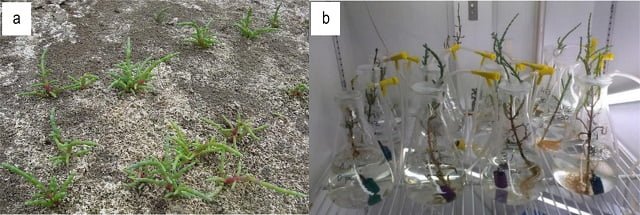
Soil salinization has become one of the most relevant global problems, as it damages soil structure, reduces fertility, and negatively impacts agro-industrial activities and water availability for the population.
Land-based mariculture is one of the main sources of discharge of saline effluents. Therefore, alternatives for the bioremediation of marine aquaculture effluents must be sought.
Recent studies have shown the capacity of the halophyte Sarcocornia neei to remove and assimilate inorganic and organic nitrogen, carbon, and phosphorus compounds from hypersaline aquaculture effluents.
In this context, a team of researchers from the School of Marine Sciences at the Pontifical Catholic University of Valparaíso and Erwin Sander Elektroapparatebau GmbH evaluated the potential of reducing the salinity of S. neei in a hydroponic system, assessing its potential use as a desalination tool in the treatment of saline effluents.
Halophytes for bioremediation
In recent years, there has been increased interest in studying the use of halophytes for the bioremediation of saline effluents to provide a partial solution to this problem.
Salicornia and Sarcocornia are among the most promising halophyte genera for phytoremediation of saline waters and soils.
Despite the potential use of halophytes for reducing effluent salinity, their tolerance to salinity or their capacity to remove other nutrients has been poorly studied.
Halophyte cultivation is also important for human and animal consumption due to their nutritional value, in terms of antioxidant vitamins, minerals, and as an alternative source of omega-3 polyunsaturated fatty acids.
Stay Always Informed
Join our communities to instantly receive the most important news, reports, and analysis from the aquaculture industry.
Salinity reduction experiment
The experiments to evaluate salinity reduction consisted of cultivating S. neei in four different salinities (0, 10, 20, and 30 gL-1) in a hydroponic system.
The experiment lasted for 53 days, during which scientists recorded salinity, temperature, and conductivity, primarily.
Salinity removal capacity of Sarcocornia neei
According to the study’s results, S. neei showed significant salinity removal in all treatments. “The highest reduction in salinity was obtained in the 20 g L-1 treatment, removing 6.91 g L-1 in 53 days, which corresponds to 35% of the total NaCl added at the beginning of the experiment,” they reported.
The scientists also reported an increase in plant biomass in all treatments, with significant differences in the weight gained by plants between treatment A compared to treatment B and treatment C.
According to the scientists, “S. neei tolerates a wide range of salinity; no plant mortalities or salt stress symptoms were observed in any treatment. Neither salt precipitation nor evaporation phenomena were appreciated.”
“This study shows the first results using S. neei, a halophyte native to the coasts of Chile and other Latin American countries, to reduce NaCl in hydroponic systems. The data shows that S. neei can achieve significant reduction rates without signs of stress or mortality at different salinities, suggesting its novel use in water biodesalination. According to the obtained data, 10 and 20 g L-1 are the most suitable salinities for achieving a better performance of S. neei as a NaCl reducer in hydroponics,” the scientists emphasized.
Thus, according to the study’s results, S. neei emerges as a tool with potential for treating saline effluents from land-based marine aquaculture facilities.
The study also reports a growth rate of S. neei of 2.80 g m-2 d-1 and biomass production rates of 0.17 kg m-2 after 61 days of testing. It highlights that this species’ adaptability to high salt concentrations makes it an ideal candidate for use as a biofilter for marine aquaculture effluents.
Conclusion
“The results of this study suggest that the use of S. neei could allow partial desalination of saline effluents before their discharge into the environment,” the scientists conclude.
They recommend conducting further research to evaluate the salinity reduction capacity of the halophyte plant S. neei in larger-scale systems integrated into aquaculture facilities.
The study was funded by the “ANID-FONDECYT Postdoctoral Project No. 3210024.
Reference (open access)
Gómez Silvia, Hurtado Carlos Felipe, Orellana Jaime, Gallardo José Andrés. Salinity reduction by Sarcocornia neei in hydroponics: implications in marine aquaculture wastewater remediation. Lat. Am. J. Aquat. Res. [Internet]. 2023 Jul; 51( 3 ): 414-420. Disponible en: http://www.scielo.cl/scielo.php?script=sci_arttext&pid=S0718-560X2023000300414&lng=es. http://dx.doi.org/10.3856/vol51-issue3-fulltext-3031.
Editor at the digital magazine AquaHoy. He holds a degree in Aquaculture Biology from the National University of Santa (UNS) and a Master’s degree in Science and Innovation Management from the Polytechnic University of Valencia, with postgraduate diplomas in Business Innovation and Innovation Management. He possesses extensive experience in the aquaculture and fisheries sector, having led the Fisheries Innovation Unit of the National Program for Innovation in Fisheries and Aquaculture (PNIPA). He has served as a senior consultant in technology watch, an innovation project formulator and advisor, and a lecturer at UNS. He is a member of the Peruvian College of Biologists and was recognized by the World Aquaculture Society (WAS) in 2016 for his contribution to aquaculture.




